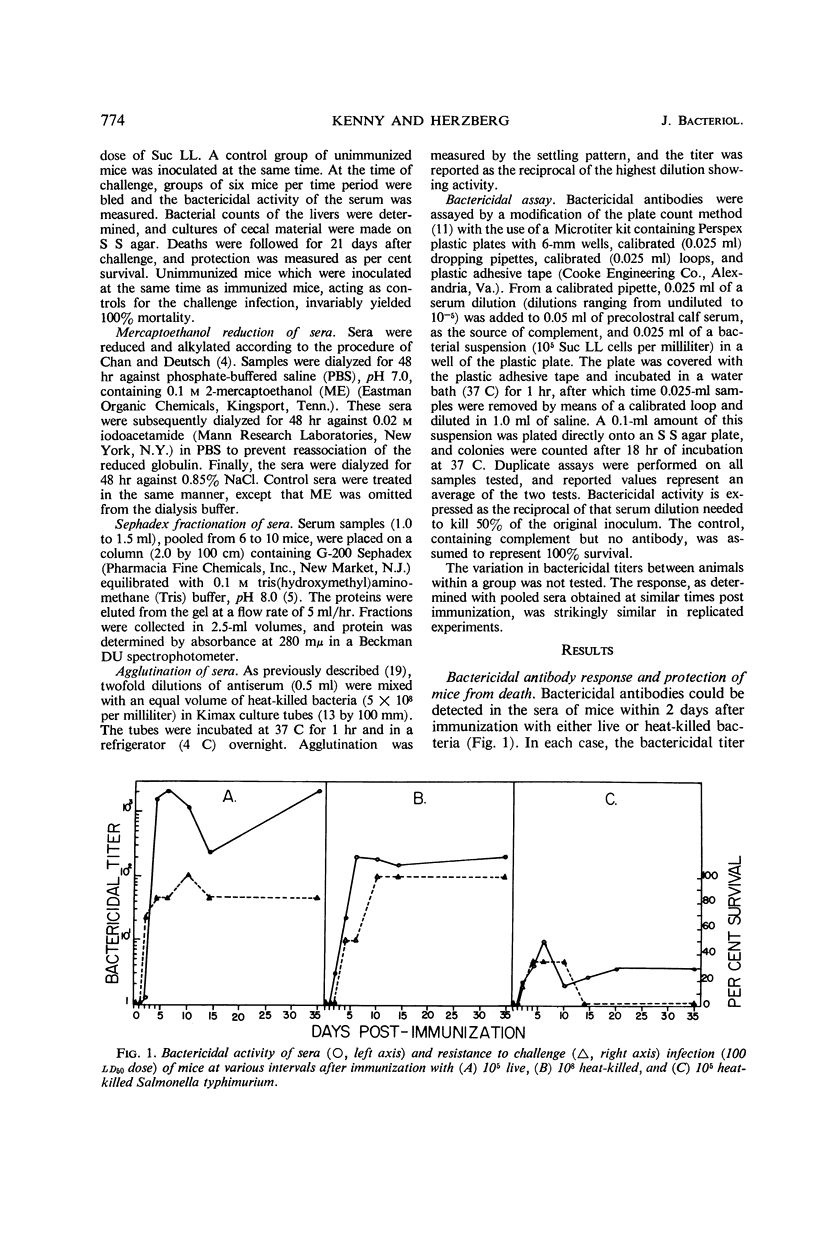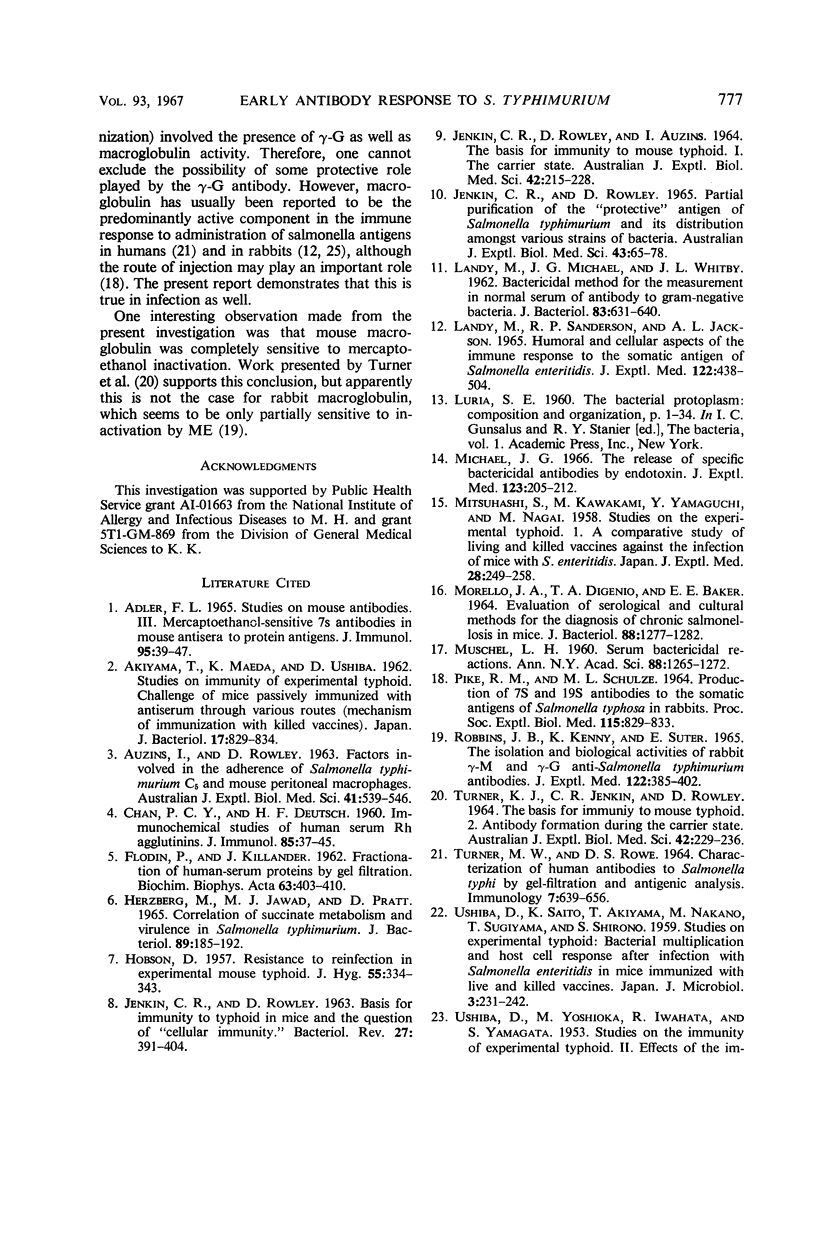Abstract
After immunization with either live or heat-killed Salmonella typhimurium, mice responded with an extremely rapid production of bactericidal antibody which was correlated with the appearance of immunity to a heavy challenge dose (100 ld50) of the virulent bacteria. Inactivation of sera with mercaptoethanol along with Sephadex fractionation indicated that the observed bactericidal activity was associated with a macroglobulin which was completely mercaptoethanol-sensitive. The unexpected finding, that a heat-killed vaccine gave excellent protection from a challenge dose which killed all unimmunized control mice, seriously challenges the theory attributing immunity against typhoid infection entirely to a cellular host factor produced only in response to a live vaccine.
Full text
PDF





Selected References
These references are in PubMed. This may not be the complete list of references from this article.
- ADLER F. L. STUDIES ON MOUSE ANTIBODIES. II. MERCAPTOETHANOL-SENSITIVE 7 S ANTIBODIES IN MOUSE ANTISERA TO PROTEIN ANTIGENS. J Immunol. 1965 Jul;95:39–47. [PubMed] [Google Scholar]
- AKIYAMA T., MAEDA K., USHIBA D. [Studies on immunity in experimental typhoid. Challenge of mice passively immunized with antiserum through various routes (mechanism of immunization with killed vaccines)]. Nihon Saikingaku Zasshi. 1962 Oct;17:829–834. [PubMed] [Google Scholar]
- AUZINS I., ROWLEY D. FACTORS INVOLVED IN THE ADHERENCE OF S. TYPHIMURIUM C5 AND MOUSE PERITONEAL MACROPHAGES. Aust J Exp Biol Med Sci. 1963 Oct;41:539–546. doi: 10.1038/icb.1963.44. [DOI] [PubMed] [Google Scholar]
- CHAN P. C., DEUTSCH H. F. Immunochemical studies of human serum Rh agglutinins. J Immunol. 1960 Jul;85:37–45. [PubMed] [Google Scholar]
- FLODIN P., KILLANDER J. Fractionation of human-serum proteins by gel filtration. Biochim Biophys Acta. 1962 Oct 8;63:402–410. doi: 10.1016/0006-3002(62)90104-x. [DOI] [PubMed] [Google Scholar]
- HERZBERG M., JAWAD M. J., PRATT D. CORRELATION OF SUCCINATE METABOLISM AND VIRULENCE IN SALMONELLA TYPHIMURIUM. J Bacteriol. 1965 Jan;89:185–192. doi: 10.1128/jb.89.1.185-192.1965. [DOI] [PMC free article] [PubMed] [Google Scholar]
- HOBSON D. Resistance to reinfection in experimental mouse typhoid. J Hyg (Lond) 1957 Sep;55(3):334–343. doi: 10.1017/s0022172400037244. [DOI] [PMC free article] [PubMed] [Google Scholar]
- JENKIN C. R., ROWLEY D., AUZINS I. THE BASIS FOR IMMUNITY TO MOUSE TYPHOID. I. THE CARRIER STATE. Aust J Exp Biol Med Sci. 1964 Apr;42:215–228. doi: 10.1038/icb.1964.23. [DOI] [PubMed] [Google Scholar]
- JENKIN C. R., ROWLEY D. BASIS FOR IMMUNITY TO TYPHOID IN MICE AND THE QUESTION OF "CELLULAR IMMUNITY". Bacteriol Rev. 1963 Dec;27:391–404. doi: 10.1128/br.27.4.391-404.1963. [DOI] [PMC free article] [PubMed] [Google Scholar]
- JENKIN C. R., ROWLEY D. PARTIAL PURIFICATION OF THE "PROTECTIVE" ANTIGEN OF SALMONELLA TYPHIMURIUM AND ITS DISTRIBUTION AMONGST VARIOUS STRAINS OF BACTERIA. Aust J Exp Biol Med Sci. 1965 Feb;43:65–78. doi: 10.1038/icb.1965.5. [DOI] [PubMed] [Google Scholar]
- LANDY M., MICHAEL J. G., WHITBY J. L. Bactericidal method for the measurement in normal serum of antibody to gramnegative bacteria. J Bacteriol. 1962 Mar;83:631–640. doi: 10.1128/jb.83.3.631-640.1962. [DOI] [PMC free article] [PubMed] [Google Scholar]
- Landy M., Sanderson R. P., Jackson A. L. Humoral and cellular aspects of the immune response to the somatic antigen of Salmonella enteritidis. J Exp Med. 1965 Sep 1;122(3):483–504. doi: 10.1084/jem.122.3.483. [DOI] [PMC free article] [PubMed] [Google Scholar]
- MITSUHASHI S., KAWAKAMI M., YAMAGUCHI Y., NAGAI M. Studies on the experimental typhoid. 1. A comparative study of living and killed vaccines against the infection of mice with S. enteritidis. Jpn J Exp Med. 1958 Aug;28(4):249–258. [PubMed] [Google Scholar]
- MORELLO J. A., DIGENIO T. A., BAKER E. E. EVALUATION OF SEROLOGICAL AND CULTURAL METHODS FOR THE DIAGNOSIS OF CHRONIC SALMONELLOSIS IN MICE. J Bacteriol. 1964 Nov;88:1277–1282. doi: 10.1128/jb.88.5.1277-1282.1964. [DOI] [PMC free article] [PubMed] [Google Scholar]
- MUSCHEL L. H. Serum bactericidal actions. Ann N Y Acad Sci. 1960 Nov 21;88:1265–1272. doi: 10.1111/j.1749-6632.1960.tb20117.x. [DOI] [PubMed] [Google Scholar]
- Michael J. G. The release of specific bactericidal antibodies by endotoxin. J Exp Med. 1966 Feb 1;123(2):205–212. doi: 10.1084/jem.123.2.205. [DOI] [PMC free article] [PubMed] [Google Scholar]
- PIKE R. M., SCHULZE M. L. PRODUCTION OF 7S AND 19S ANTIBODIES TO THE SOMATIC ANTIGENS OF SALMONELLA TYPHOSA IN RABBITS. Proc Soc Exp Biol Med. 1964 Mar;115:829–833. doi: 10.3181/00379727-115-29050. [DOI] [PubMed] [Google Scholar]
- ROBBINS J. B., KENNY K., SUTER E. THE ISOLATION AND BIOLOGICAL ACTIVITIES OF RABBIT GAMMA M- AND GAMMA G-ANTI-SALMONELLA TYPHIMURIUM ANTIBODIES. J Exp Med. 1965 Aug 1;122:385–402. doi: 10.1084/jem.122.2.385. [DOI] [PMC free article] [PubMed] [Google Scholar]
- TURNER K. J., JENKIN C. R., ROWLEY D. THE BASIS FOR IMMUNITY TO MOUSE TYPHOID. 2. ANTIBODY FORMATION DURING THE CARRIER STATE. Aust J Exp Biol Med Sci. 1964 Apr;42:229–236. doi: 10.1038/icb.1964.24. [DOI] [PubMed] [Google Scholar]
- TURNER M. W., ROWE D. S. CHARACTERIZATION OF HUMAN ANTIBODIES TO SALMONELLA TYPHI BY GEL-FILTRATION AND ANTIGENIC ANALYSIS. Immunology. 1964 Nov;7:639–656. [PMC free article] [PubMed] [Google Scholar]
- USHIBA D., SAITO K., AKIYAMA T., NAKANO M., SUGIYAMA T., SHIRONO S. Studies on experimental typhoid: bacterial multiplication and host cell response after infection with Salmonella enteritidis in mice immunized with live and killed vaccines. Jpn J Microbiol. 1959 Apr;3:231–242. doi: 10.1111/j.1348-0421.1959.tb00119.x. [DOI] [PubMed] [Google Scholar]
- WEIDANZ W. P., JACKSON A. L., LANDY M. SOME ASPECTS OF THE ANTIBODY RESPONSE OF RABBITS TO IMMUNIZATION WITH ENTEROBACTERIAL SOMATIC ANTIGENS. Proc Soc Exp Biol Med. 1964 Jul;116:832–837. doi: 10.3181/00379727-116-29386. [DOI] [PubMed] [Google Scholar]
- WHITBY J. L., MICHAEL J. G., WOODS M. W., LANDY M. Symposium on bacterial endotoxins. II. Possible mechanisms whereby endotoxins evoke increased nonspecific resistance to infection. Bacteriol Rev. 1961 Dec;25:437–446. doi: 10.1128/br.25.4.437-446.1961. [DOI] [PMC free article] [PubMed] [Google Scholar]


